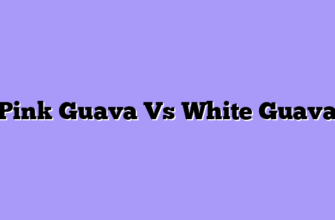The guava, a tropical fruit cherished for its sweet and tangy flavor, is a treasure trove of nutrients and culinary versatility. Its fleshy interior, known as the pulp, is the star of the show, offering a delightful combination of taste and texture. This article delves into the fascinating world of guava pulp, exploring its composition, nutritional value, and culinary applications.
The Sweet and Juicy Guava Pulp
Guava pulp is the soft, edible flesh that lies beneath the fruit’s skin. It is typically a vibrant pink or yellow color, depending on the variety of guava. The pulp’s texture can range from firm and slightly grainy to soft and creamy, depending on the ripeness of the fruit. This variation in texture is a testament to the guava’s adaptability, allowing it to be enjoyed in a variety of ways.
Beyond its pleasing appearance and texture, guava pulp is a nutritional powerhouse. It is an excellent source of vitamin C, an essential antioxidant that supports immune function and collagen production. Guava pulp is also rich in dietary fiber, which aids in digestion and promotes satiety. Additionally, it contains potassium, a mineral vital for maintaining healthy blood pressure and muscle function.
The culinary applications of guava pulp are as diverse as its nutritional profile. It can be enjoyed fresh, adding a burst of sweetness and tanginess to salads, smoothies, and yogurt parfaits. Guava pulp is also a popular ingredient in jams, jellies, and chutneys, where its natural sweetness and pectin content contribute to a delightful texture. In some cultures, guava pulp is used to make refreshing beverages, such as juices and sorbets.
The versatility of guava pulp extends beyond its culinary uses. It is often incorporated into beauty products, leveraging its antioxidant properties to protect the skin from environmental damage. Guava pulp is also used in traditional medicine, where it is believed to have anti-inflammatory and antibacterial properties.
The Crunchy and Flavorful Guava Seeds
Guava seeds, typically brown or black in color, are encased in a hard outer shell. This shell, though seemingly unyielding, is easily broken down by the digestive system, releasing the nutritional treasures within. These seeds are rich in dietary fiber, a crucial component for maintaining a healthy digestive system. Fiber aids in regulating bowel movements, preventing constipation, and promoting a feeling of fullness.
Beyond their digestive benefits, guava seeds are a valuable source of antioxidants. These potent compounds, such as flavonoids and tannins, combat free radicals in the body, protecting cells from damage and reducing the risk of chronic diseases. Studies have shown that guava seeds possess anti-inflammatory properties, potentially contributing to the prevention of conditions like arthritis and heart disease.

While the crunchy texture of guava seeds may not appeal to everyone, there are ways to incorporate them into your diet. They can be eaten raw, adding a delightful crunch to smoothies, salads, or yogurt. For those who prefer a smoother texture, the seeds can be ground into a powder and used as a flavoring agent in baked goods or beverages.
In some cultures, guava seeds are used in traditional medicine. They are believed to have diuretic properties, aiding in the removal of excess water from the body. Additionally, they are thought to possess anti-bacterial and anti-fungal properties, making them a potential remedy for certain infections.
The Aromatic and Fragrant Guava Skin
The guava skin, a thin, leathery layer that encases the fleshy interior, is a powerhouse of antioxidants. These potent compounds, such as flavonoids and vitamin C, act as natural defenders against free radicals, protecting the body from oxidative stress and its associated health risks. Studies have shown that guava skin extracts exhibit strong antioxidant activity, surpassing even the antioxidant capacity of the fruit’s flesh.
Beyond its antioxidant prowess, the guava skin is a rich source of dietary fiber. This essential nutrient aids in digestion, promoting regularity and preventing constipation. The fiber content in guava skin also contributes to a feeling of fullness, making it a valuable addition to weight management strategies.
The guava skin’s unique flavor profile adds a distinct dimension to culinary creations. Its subtle sweetness, combined with a hint of tartness and a captivating aroma, can elevate dishes from ordinary to extraordinary. In many cultures, the skin is traditionally used to make jams, jellies, and chutneys, adding a burst of flavor and texture to savory and sweet dishes alike.
The guava skin’s versatility extends beyond culinary applications. Its natural astringent properties make it a valuable ingredient in skincare products. The skin’s high vitamin C content promotes collagen production, contributing to a youthful and radiant complexion. It also possesses antibacterial and antifungal properties, making it an effective remedy for acne and other skin conditions.
While the guava skin offers a plethora of benefits, it’s important to note that some individuals may experience mild digestive discomfort when consuming it raw. This is due to the presence of tannins, which can cause a slight astringent sensation. However, this can be mitigated by incorporating the skin into cooked dishes or by removing the outer layer before consumption.
The Nutritional Benefits of Guava Fruit
The flesh of the guava, the edible portion, is where the majority of its nutritional value lies. It is a rich source of vitamin C, an essential antioxidant that supports immune function, collagen production, and wound healing. Guava also contains a significant amount of vitamin A, crucial for maintaining healthy vision, skin, and cell growth. Additionally, the flesh is a good source of potassium, a mineral that helps regulate blood pressure and muscle function.
Beyond the flesh, the guava’s skin also offers nutritional benefits. While some people prefer to peel the fruit, the skin is actually packed with fiber, which aids digestion and promotes satiety. It also contains antioxidants, such as lycopene, which has been linked to a reduced risk of certain cancers. However, it’s important to note that the skin can be slightly bitter, so it’s best to consume it in moderation or choose varieties with thinner skins.
The seeds of the guava, often overlooked, are another source of nutrients. They are rich in fiber and contain omega-3 fatty acids, which are beneficial for heart health and brain function. While the seeds can be slightly crunchy, they can be consumed whole or ground into a powder for use in smoothies or other recipes.
The guava’s leaves, while not typically consumed directly, have been used in traditional medicine for centuries. They are known for their anti-inflammatory and antibacterial properties, and have been used to treat various ailments, including diarrhea, fever, and skin infections. However, it’s important to consult with a healthcare professional before using guava leaves for medicinal purposes.
The Culinary Uses of Guava Fruit Parts
The most familiar part of the guava is its fleshy pulp, which is typically eaten fresh or used in various culinary preparations. The pulp’s sweetness and subtle tanginess make it ideal for jams, jellies, and preserves. It can also be incorporated into smoothies, juices, and sorbets, adding a refreshing tropical flavor. Guava pulp is often used in baking, lending a unique sweetness and aroma to cakes, muffins, and pies.
Beyond the pulp, the guava’s skin holds culinary potential. While some may find the skin slightly bitter, it can be used to add a distinct flavor and texture to dishes. In some cultures, the skin is dried and ground into a powder, which can be used as a spice or flavoring agent. The skin can also be candied, creating a sweet and chewy treat.
The seeds of the guava, often discarded, are a source of nutrients and can be incorporated into various dishes. They have a slightly crunchy texture and a nutty flavor. In some regions, the seeds are roasted and ground into a powder, which can be used as a thickener or flavoring agent in soups, stews, and sauces. The seeds can also be added to granola bars, trail mixes, and other snacks for a boost of texture and flavor.
The leaves of the guava tree are also used in culinary applications, particularly in traditional medicine. They have a slightly bitter and astringent flavor and are often used to make herbal teas. Guava leaf tea is believed to have various health benefits, including aiding digestion and reducing inflammation. The leaves can also be used as a natural food preservative, extending the shelf life of fruits and vegetables.
The guava fruit, in its entirety, offers a range of culinary possibilities. From the sweet and juicy pulp to the slightly bitter skin and the crunchy seeds, each part contributes unique flavors and textures to dishes. By exploring the diverse culinary uses of the guava fruit, we can unlock a world of flavor and appreciate the versatility of this tropical treasure.
Q&A
**1. What is the outer layer of a guava called?**
* **Answer:** Skin or rind
**2. What is the fleshy, edible part of a guava called?**
* **Answer:** Pulp
**3. What are the small, hard seeds found inside the guava called?**
* **Answer:** Seeds
**4. What is the white, milky substance found in some guava varieties called?**
* **Answer:** Latex
**5. What is the name of the small, green, leaf-like structure at the top of the guava?**
* **Answer:** CalyxThe guava fruit is a complex structure with distinct parts, each contributing to its unique flavor, texture, and nutritional value. The edible flesh, rich in vitamins and antioxidants, is surrounded by a thin, aromatic skin. The numerous seeds, while edible, add a slightly crunchy texture. Understanding the different parts of the guava fruit allows for a deeper appreciation of its culinary and nutritional benefits.








